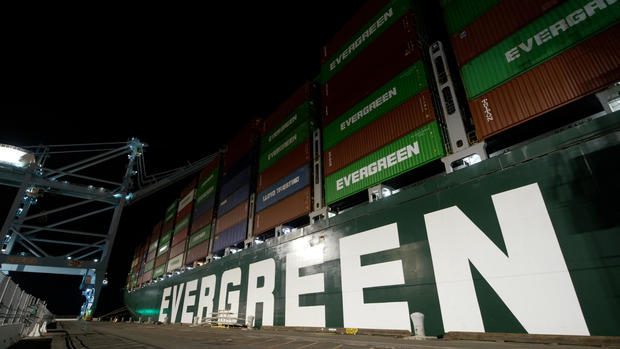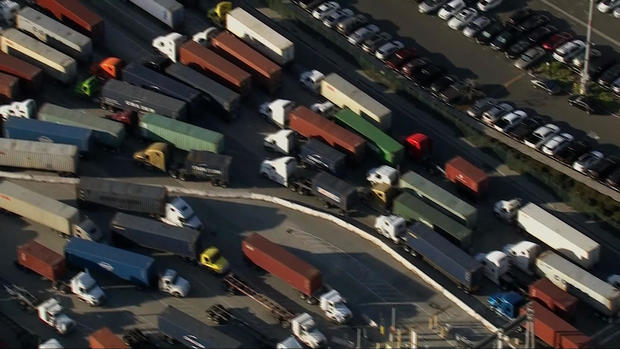Holiday gifts delayed? Here's where — and why — they may be stuck
From Atlantic to Pacific, gee the traffic is terrific. But this holiday season, the traditional logjam of congestion is shaping up to be more than just weary travelers.
When Covid first hit and the world went into lock-down, manufacturing fell off a cliff. But by June 2020, thanks, in part, to massive fiscal stimulus, cashed-up Americans went on a shopping binge. Most assumed overseas factories in Asia would catch up with demand after a few months. It hasn't worked out that way. The flood of online sales has clogged a supply chain unable to handle the record-breaking volume of cargo from Asia glutting west coast ports.
Now with the holidays fast approaching, consumers, retailers, and factory owners are trying to find out where their goods are. The answer likely lies somewhere along a complex global supply chain.
This week on 60 Minutes, Bill Whitaker reported from the ports of Los Angeles and Long Beach to see the massive cargo bottleneck first-hand. The California gateways are the busiest container ports in the U.S., with about 40 percent of all domestic imports coming through those two venues.
Imports from Asia — including toys, clothing, furniture, household goods, and raw materials that American factories use to build products domestically — are packed in steel shipping containers. Those containers are stacked as many as nine high on cargo ships that can stretch the length of three football fields.
The Asia-to-U.S. routes are now the most profitable on the planet. There are so many ships that scores must wait outside the California harbors, waiting for a berth to dock. The ships used to dock within thirty minutes of their arrival time; now it can take weeks.
But because the docks are so full, there is precious little space for dockworkers to unload new containers. Once a ship is docked at port, it takes an average of nine days to unload the ship and move the cargo off the docks. It used to take two.
There is no more vital player to the smooth running of the supply chain than truckers. Two-thirds of the cargo at the ports of Los Angeles and Long Beach are hauled away by trucks. The ocean carriers and terminals say there are not enough truck drivers willing to work at the ports, and that, they offer, is why the containers are remaining on the docks for so long.
But the head of the Harbor Trucking Association, Matt Schrap, told 60 Minutes there is no driver shortage. Instead, he blames the bottlenecks on the ports' antiquated booking system that regulates how cargo is moved on and off the docks.
Usually, truckers must first make an appointment at a terminal to return an empty container before picking up a full one. But the avalanche of imports has warped the system. With no space to spare, the terminals have placed new restrictions on when, where — even the color of the container — the trucker can return. Each terminal has its own set of rules. Because there is no centralized database, truckers hedge their bets by making multiple appointments at different terminals hoping they'll meet the requirements and be able to return an empty container.
Prior to the trucker's appointed pickup time, the marine terminal may be full, and truck drivers can be turned away at the last minute, usually after a long wait in line.
If truckers are turned away from the port, they park the empty containers at trucks lots strewn all over southern California. The chassis — the metal undercarriage the container sits on — is stuck with the empty container, taking a vital piece of equipment out of circulation. Without a chassis, a truck cannot move a container. That means they cannot haul a full container away from the dock.
Schrap told 60 Minutes one solution would be for the ocean carriers to send something called sweeper ships from Asia to pick up the all the empty containers, which would free up space on the docks.
American rail lines have also been overwhelmed by the influx of goods. 60 Minutes met Rick Woldenberg, who runs the educational toy company Learning Resources outside Chicago. Woldenberg saw the backlog coming early and ordered a large shipment of toys this past spring.
But he was not the only one who ordered early. The ensuing congestion at the rail yards meant that Woldenberg's shipment ended up at the bottom of a stack of containers, making them inaccessible to him for nine weeks.
No one 60 Minutes spoke with was optimistic the bottleneck would be figured out within the next few weeks. The White House has put a high-level task force on the problems, and the meetings among all the players are continuing.
"Everybody is trying to respond with some piece of the solution," Whitaker said, detailing his reporting on the broadcast. "But so far, it hasn't all come together in a complete puzzle. And it doesn't look like it's all going to come together before Christmas."
The video above was produced by Brit McCandless Farmer and Will Croxton. It was edited by Will Croxton.





